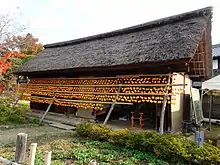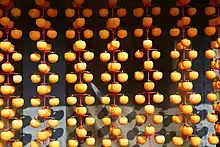Dried persimmon
Dried persimmon is a type of traditional dried fruit snack in East Asia.[1] Known as shìbǐng (柿餅) in Chinese, hoshigaki (干し柿) in Japanese, and gotgam (곶감) in Korean, it is traditionally made in the winter, by air drying Oriental persimmon. It is a popular snack food in East Asia, and is also used to make wine, and in creating other desserts.
.jpg.webp) Dried persimmons | |
| Alternative names | Dried persimmon |
|---|---|
| Type | Dried fruit |
| Region or state | East Asia |
| Main ingredients | Oriental persimmon |
Production
_DSCF0017.jpg.webp)

Dried persimmon are made from various varieties of Oriental persimmon. Persimmons, when fully ripe, are thin-skinned, soft and sweet. Persimmons used to create dried persimmons are harvested when they are under-ripe, firm, astringent, and bitter.[2]
China
In China, the persimmon fruit are peeled and dried on wooden trays after harvesting.
Japan
In Japan, the fruit are peeled and then suspended by strings from their stems.[3] They are massaged daily after they have started to dry.[4] This gives the dried persimmon from Japan a distinctive shape and texture that is different from those from China and Korea.[5] Anpo-gaki is a variation of Japanese dried persimmon in which the persimmon is dried by fumigating with sulphur, resulting in a soft, juicy texture.[6]
Korea
In Korea, the persimmons are peeled and dried, tied with saekki (rice straw ropes) and hung in sunny, well-ventilated place, for example to the eaves of the house.[7][8] When the color turns brown and the outer part hardens, the seeds are removed and the persimmons are sealed again and flattened.[9] After around three weeks, when the fruits reach 75% of their original weight, they are covered in dried rice straw and stored in a box in a cool place until the drying process is completed, and a white powdery crust of persimmon sugar forms on the outside.[1] Sangju in North Gyeongsang Province is famous for its dried persimmons.[10][11]
Nutrition

Korean gotgam usually consists of 32% moisture, 6.3% protein, 0.44% fat, 44.8% carbohydrate, 15% fiber, and 1.99% ash.[9] calories (32g/ea) : 75.8kcal
Culinary use
In Korean cuisine, dried persimmons can be consumed themselves, or used as an ingredient in other foods. For example, gotgam-ssam (dried persimmon wrap) is made by wrapping a walnut with dried persimmon.[9] Dried persimmon with pine nuts inserted are served with suksil-gwa (a fruit confection) or fresh fruits.[9] Dried persimmons are also one of the main ingredients for sujeonggwa (cinnamon punch).[9]
In popular culture
The Korean folktale "The Tiger and the Dried Persimmon" features a tiger scared of dried persimmon.[12][13]
Gallery
 Hoshigaki served as a snack in Japan
Hoshigaki served as a snack in Japan Sliced gotgam served as a snack in Korea
Sliced gotgam served as a snack in Korea Korean gotgam-mari (dried persimmon rolls) served with strawberries and Andong sikhye
Korean gotgam-mari (dried persimmon rolls) served with strawberries and Andong sikhye.jpg.webp) Japanese kagami mochi served with dried persimmon-skewers
Japanese kagami mochi served with dried persimmon-skewers
References
- Means, Becky (2 August 2010). "Dried Persimmon". Houston Press. Retrieved 3 June 2017.
- "gotgam" 곶감. Doopedia (in Korean). Doosan Corporation. Retrieved 3 June 2017.
- Wan Yan Ling. "Grocery Ninja: Dried Persimmons Are a Taste of Honeyed Sunshine". www.seriouseats.com. Serious Eats. Retrieved 15 May 2018.
- "How To Make Hoshigaki (Dried Persimmons)". Root Simple. 13 November 2012. Retrieved 15 May 2018.
- Mucci, Kristy (November 15, 2016). "This is the Kobe Beef of Dried Fruit". SAVEUR. Retrieved 19 May 2018.
- "Go Go Tohoku". www.facebook.com. Retrieved 2020-09-01.
- Korea Tourism Organization (5 October 2016). "Seasonal foods to eat this fall". Stripes. Archived from the original on 1 August 2017. Retrieved 3 June 2017.
- "First lady to treat Trump couple with personally made refreshments". Yonhap News Agency. 7 November 2017. Retrieved 20 May 2018.
- 이, 효지. "gotgam" 곶감. Encyclopedia of Korean Culture (in Korean). Academy of Korean Studies. Retrieved 3 June 2017.
- Chung, Kyung-a (October 2014). "Season of Beauty, Season of Plenty". KOREA. Korean Culture and Information Service. Archived from the original on 13 August 2017. Retrieved 3 June 2017.
- Kim, Sun-mi; Kim, Sarah (20 August 2015). "Taste of a fruit is the only trace of a happy youth". Korea JoongAng Daily. Retrieved 3 June 2017.
- Wi, Ki-cheol (2004). The Tiger and Dried Persimmon. Kookminbooks. ISBN 8911022241. Lay summary – Korea Literature Translation Institute.
- "The Tiger and the Persimmon" (PDF). Jordan Schnitzer Museum of Art. University of Oregon. Retrieved 3 June 2017. Lay summary.
